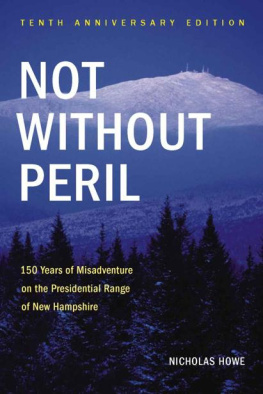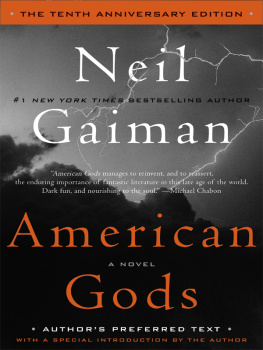ADDITIONAL PRAISE FOR THE FIRST
EDITION OF NOT WITHOUT PERIL
Not Without Peril is an outstanding addition to the literature of mountaineering. Howes work gives us a masterful, riveting, and meticulously researched account of some of the most tragic encounters with the wrath of the White Mountains. These stories are made even more chilling because of the accessibility of these mountains to the recreational hiker.Donna Urey, President, New England Booksellers Association
This should be required reading for anyone who will beor has already gonehiking in the mountains.Nelly Heitman, Foreword Magazine
Howe tells the stories straightforwardly deftly blending in the historical and geographical information needed to make them complete. Not Without Peril makes a memorable, informative, and ultimately sobering read about the high peaks of the Northeast. Sentinel & Enterprise, Leominster, Mass.
Between the excellent prose, the interesting historical details and the riveting accounts of misadventure, Not Without Peril will be appreciated by anyone with an interest in outdoor recreation or in the Presidential Mountains of New Hampshire. Reading about these mountains is gripping. The Bridgton News, Bridgton, Maine
Nick Howe has tramped virtually every inch of Mount Washingtons surface, and with this book he becomes its preeminent historian. That he happens also to be a graceful and charming storyteller is pure bonus. Not Without Peril is a compulsively readable thrilleractually, a series of thrillers. It will hold equal fascination for mountain lovers and flatlanders and for anyone who enjoys a good read.John Jerome, author of On Turning Sixty-Five, The Elements of Effort, Stone Work, and The Sweet Spot in Time
In essays that preface each episode, Howe examines the odd circumstances that surround it and the occasional ripple effects of death in the mountains.D. Quincy Whitney, The Boston Globe
Fans of outdoor disaster and unpleasantry, as well as collectors of New England mountain lore, will find Howe a generally satisfying guide to New Hampshires dark side. Kirkus Reviews
NOT
WITHOUT
PERIL
150 Years of Misadventure
on the Presidential Range
of New Hampshire
Tenth Anniversary Edition
NICHOLAS HOWE
Appalachian Mountain Club Books
Boston, Massachusetts
The AMC is a nonprofit organization and sales of AMC books fund our mission of protecting the Northeast outdoors. If you appreciate our efforts and would like to make a donation to the AMC, contact us at Appalachian Mountain Club, 5 Joy Street, Boston, MA 02108.
http://www.outdoors.org/publications/books
Book design by Eric Edstam
eBook design by eBook Architects
Front cover image Jerry and Marcy Monkman, www.ecophotography.com
Maps by Louis F. Cutter. Excerpted from Appalachian Mountain Club Map of Mount
Washington Range, copyright 1992 Appalachian Mountain Club.
Text copyright 2000, 2009 Nicholas Howe. All rights reserved.
Distributed by The Globe Pequot Press, Guilford, Connecticut.
Published by the Appalachian Mountain Club. No part of this publication may be reproduced or transmitted in any form or by any means, electronic or mechanical, including photocopying and recording, or by any information storage or retrieval system, except as may be expressly permitted by the 1976 Copyright Act or in writing from the publisher.
The Library of Congress cataloged the printed edition as follows:
Howe, Nicholas S.
Not without peril : 150 years of misadventure on the Presidential Range of New Hampshire / Nicholas Howe. 10th anniversary ed. p. cm. ISBN 978-1-934028-32-2 (alk. paper)
1. MountaineeringNew HampshirePresidential RangeHistory. 2. Presidential Range (N.H.)History. I. Title.
GV199.42.N42P744 2010 796.522097421dc22 2009027665
The paper used in this publication meets the minimum requirements of the American National Standard for Information SciencesPermanence of Paper for Printed Library Materials, ANSI Z39.48-1984.
T here have been joys too great to be described in words, and there have been griefs upon which I have dared not to dwell, and with these in mind I must say, climb if you will, but remember that courage and strength are naught without prudence, and that a momentary negligence may destroy the happiness of a lifetime. Do nothing in haste, look well to each step, and from the beginning think what may be the end.
EDWARD WHYMPER, who made the first ascent of the Matterhorn with six others in 1865. On the way down, four of his companions fell to their deaths.
Contents

The Southern Presidentials, as seen from Mount Washington.

Mount Washington, with Tuckerman Ravine on the left and Huntington Ravine on the right.

The Northern Presidentials as seen from Mount Washington over Great Gulf: Mount Clay is on the left, Mount Jefferson is in the middle, and Mount Adams on the far right.
Chapter One
IN THE BEGINNING
M OUNTAINS WERE INVENTED IN THE 19TH CENTURY. There had always been high places, of course, but the ancients usually thought that the gods lived there and avoided them for fear of giving offense. More recently, settlers considered mountains to be a piece of bad luck, a barrier to travel, and a hindrance to farming. One of my forebears was named Jemima Tute and she lived on the western frontier when the frontier was at the Connecticut River. There were two mountain ranges within reach, but no one in her family went hiking. If their eyes were open they were working, and they held off all the Indian attacks except the last one.
The high mountains of New England were approached slowly. They were first reported by a coastwise navigator in 1524, and early news was a mixture of wonder, dread, and confusion. One account was A Voyage into New England, published in London in 1628: This River (sawco), as I am told by the Savages, cometh from a great mountain called the Cristall hill, being as they say 100 miles in the Country, yet it is to be seene at the sea side, and there is no ship ariuse in NEW ENGLAND, either to the West so farre as Cape Cod, or to the East so farre as Monhiggen, but they see this Mountaine the first land, if the weather be cleere.
The ecology of the new world was not yet subject to rigorous study and some seaborn observers wrapped themselves in the mantle of whatever science as was available, so they attributed the brightness of that inland Mountaine to white moss. Others heard the optimistic accounts of distant sightings and early speculators, and thought it might be the sheen of precious stones. One gazeteer of 1638 brought less promising news; he pushed northwards from the Massachusetts settlements, but the track became difficult and he reported that the regions ahead were daunting terrible, so he turned back.
If hed persevered, he would have learned that the Cristall hill was Agiocochook, the highest point in the northeastern quarter of the North American continent. This distinction loomed large in the Indian culture of the region, and those natives dared not tread the heights that were reserved for the gods. When the summit was finally reached, the attempt was not inspired by any sense of adventure or scientific inquiry, it was politics.














